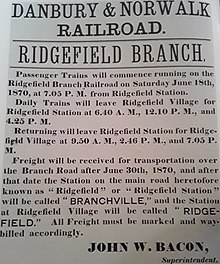
The Metro-North Commuter Railroad Company, also branded as MTA Metro-North Railroad and commonly called simply Metro-North, is a suburban commuter rail service operated by the Metropolitan Transportation Authority (MTA), a public authority of the U.S. state of New York. Metro-North serves the New York Metropolitan Area, running service between New York City and its northern suburbs in New York and Connecticut, including Port Jervis, Spring Valley, Poughkeepsie, Yonkers, New Rochelle, Mount Vernon, White Plains, Southeast and Wassaic in New York and Stamford, New Canaan, Danbury, Bridgeport, Waterbury, and New Haven in Connecticut. Service in Connecticut is operated under contract with the Connecticut Department of Transportation. Similarly, service on lines west of the Hudson River is operated under contract with NJ Transit. Metro-North also provides local rail service within the New York City boroughs of Manhattan and the Bronx.
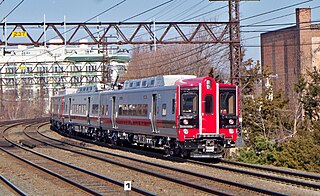
The New Haven Line is a 72.7 mi (117.0 km) commuter rail line operated by the Metro-North Railroad in the U.S. states of New York and Connecticut. Running from New Haven, Connecticut, to New York City, the New Haven Line joins the Harlem Line in Mount Vernon, New York, and continues south to Grand Central Terminal in Manhattan. The New Haven Line carries 125,000 passengers every weekday and 39 million passengers a year. The busiest intermediate station is Stamford, with 8.4 million passengers, or 21% of the line's ridership.

The Housatonic Railroad is a Class III railroad operating in southwestern New England and eastern New York. It was chartered in 1983 to operate a short section of ex-New York, New Haven and Hartford Railroad in northwestern Connecticut, and has since expanded north and south, as well as west into New York State.

The Danbury Branch is a diesel branch of the Metro-North Railroad's New Haven Line in the U.S. state of Connecticut, running from downtown Norwalk north to Danbury. It opened in 1852 as the Danbury and Norwalk Railroad. Until the early 1970s, passenger service continued north from Danbury to Canaan, Connecticut, and Pittsfield, Massachusetts. Metro-North took over operation of the line from Conrail in 1983, and the modern-day branch is mostly single-tracked.

The Danbury and Norwalk Railroad, chartered in 1836 as the Fairfield County Railroad, was an independent American railroad that operated between the cities of Danbury and Norwalk, Connecticut from 1852 until its absorption by the Housatonic Railroad in 1886. The right of way established by the D&N continues in operation and is now the Danbury Branch of the New Haven Line of the Metro-North Railroad.

Danbury station is a commuter rail station on the Danbury Branch of the Metro-North Railroad New Haven Line, located in Danbury, Connecticut. The station is the northern terminus of the Danbury Branch.

Bethel station is a commuter rail station on the Danbury Branch of the Metro-North Railroad New Haven Line, located in Bethel, Connecticut.
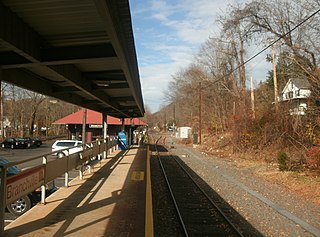
Branchville station is a commuter rail station on the Danbury Branch of the Metro-North Railroad New Haven Line, located in the Branchville neighborhood of Ridgefield, Connecticut.
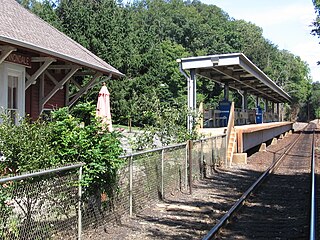
Cannondale station is a commuter rail station on the Danbury Branch of the Metro-North Railroad's New Haven Line, located in the Cannondale neighborhood of Wilton, Connecticut. The station building was added to the National Register of Historic Places in 1992 as part of the Cannondale Historic District.

East Norwalk station is a commuter rail station on the Metro-North Railroad New Haven Line, located in the East Norwalk neighborhood of Norwalk, Connecticut. The station building was constructed by Metro-North in the 1980s.
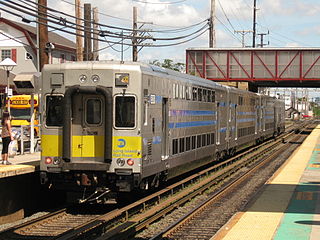
The Oyster Bay Branch is a rail line and service owned and operated by the Long Island Rail Road in the U.S. state of New York. The branch splits from the Main Line just east of Mineola station, and runs north and east to Oyster Bay. The branch is electrified between East Williston and Mineola. The branch opened in segments between 1865 and 1889.
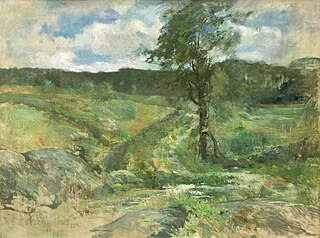
Branchville is a neighborhood of the town of Ridgefield in Fairfield County, Connecticut, United States, and is also the name of a Metro North railroad station. Branchville was listed as a census-designated place (CDP) prior to the 2020 census.

The Shepaug, Litchfield and Northern Railroad was a short independent railroad in western Connecticut that was chartered as the Shepaug Valley Railroad in 1868 and operated from 1872 to 1891 when it was taken over by the Housatonic Railroad. In 1898, the Housatonic operation was assumed by the New York, New Haven & Hartford Railroad (NH). As the Litchfield Division of the NH, the line was operated until abandonment in 1948. Much of the line remains as a rail trail.

Brookfield station is a proposed passenger rail station on the Danbury Branch of the Metro-North Railroad New Haven Line, to be located in Brookfield, Connecticut.

Norwalk station was a station on the Danbury and Norwalk Railroad located in Norwalk, Connecticut. It opened in 1852 and closed around 1956. A new station at the site has been considered.
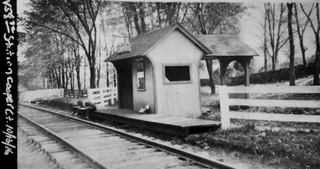
Cooper station was a stop on the Ridgefield Branch of the Danbury and Norwalk Railroad and later the New York, New Haven, and Hartford Railroad. Opened c. 1885 as a flag stop in the town of Ridgefield, Connecticut, the station was closed in 1925 when passenger service on the Ridgefield branch was discontinued. The station existed alongside the Florida and Ridgefield stations along the branch. Cooper was named so due to the namesake street it was located on which was in turn named for an unidentified cooper who operated a workshop in the vicinity.
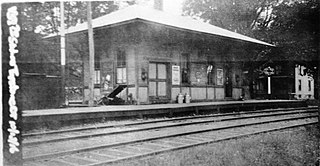
Sanford station was a passenger rail station on the Danbury and Norwalk Railroad and later the Danbury Branch of both the Housatonic Railroad and the New York, New Haven, and Hartford Railroad. The station was located on the border between Ridgefield and Redding, Connecticut, and was located on Topstone Road. Opened in 1852 as a flag stop and located in the Topstone section of Redding, Connecticut, the original station building was destroyed in 1891 by a speeding freight train. A new station building was erected the following year and would serve until the station's closure in 1938. The station was called so because of the numerous families named Sanford in the area surrounding the station.

Mill Plain was a station on the main line of the New York and New England Railroad and later the Maybrook Line of the New York, New Haven, and Hartford Railroad. Opened in 1881, the station was originally located in the Mill Plain area in the western part of Danbury, Connecticut. The station was closed in 1928 and served multiple purposes from 1930 until 2018. The station building was restored and moved to the Danbury Railway Museum in 2019.

Winnipauk was a station on the Danbury and Norwalk Railroad and later the Danbury Branch of the Housatonic Railroad and the New York, New Haven, and Hartford Railroad. Located in the Winnipauk section of the northern part of Norwalk, Connecticut, the station opened in 1852 and was an important stop that served nearby mills before it was closed in 1929.

The Ridgefield Branch was a branch line of the Danbury and Norwalk Railroad and later the New York, New Haven and Hartford Railroad. It ran for 4.0 miles (6.4 km) from Branchville to the center of Ridgefield, Connecticut. After a difficult and costly construction hindered by the topography of the Norwalk River valley, the branch opened in July 1870 after a year of construction. Throughout its existence, three stations existed on the line. In 1925, amid electrification of the neighboring Danbury Line, passenger service on the branch was terminated. Freight service continued to just the Ridgefield station until 1964, when the line was abandoned entirely.


